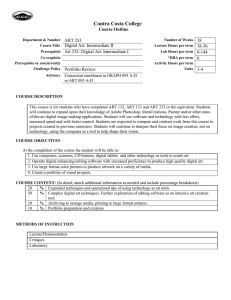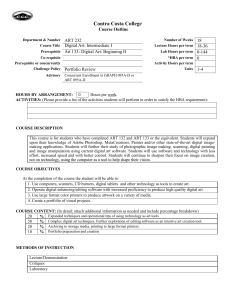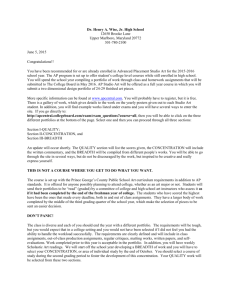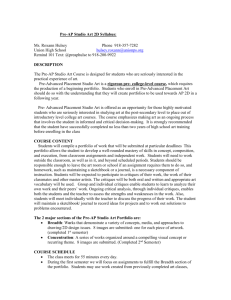AP Photography
advertisement
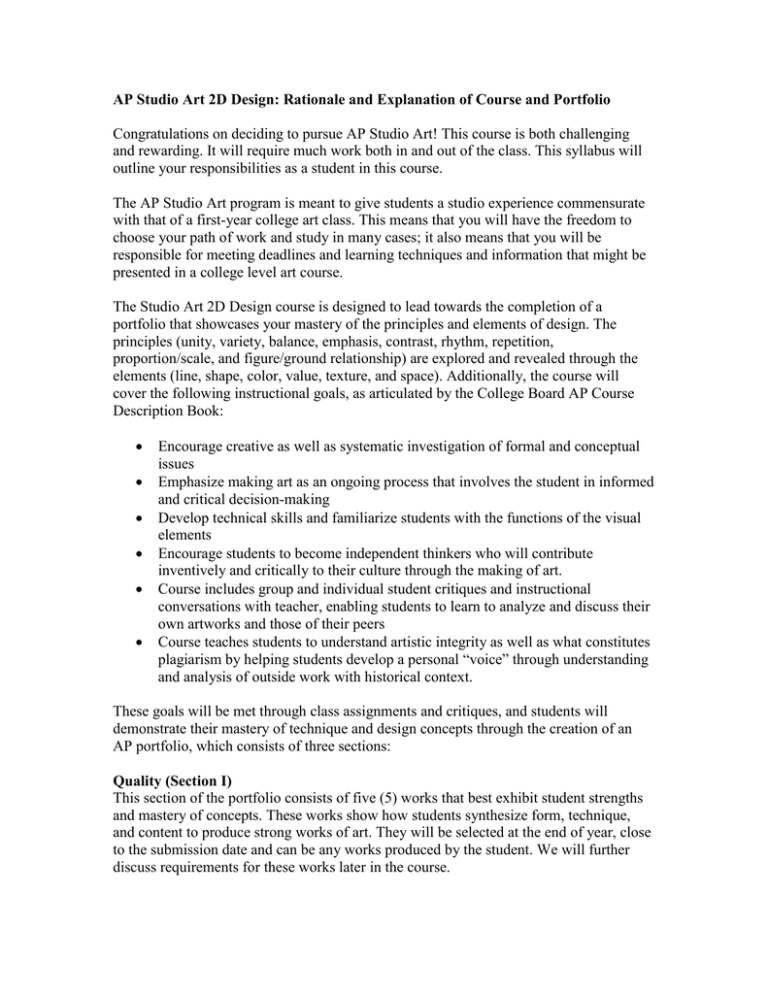
AP Studio Art 2D Design: Rationale and Explanation of Course and Portfolio Congratulations on deciding to pursue AP Studio Art! This course is both challenging and rewarding. It will require much work both in and out of the class. This syllabus will outline your responsibilities as a student in this course. The AP Studio Art program is meant to give students a studio experience commensurate with that of a first-year college art class. This means that you will have the freedom to choose your path of work and study in many cases; it also means that you will be responsible for meeting deadlines and learning techniques and information that might be presented in a college level art course. The Studio Art 2D Design course is designed to lead towards the completion of a portfolio that showcases your mastery of the principles and elements of design. The principles (unity, variety, balance, emphasis, contrast, rhythm, repetition, proportion/scale, and figure/ground relationship) are explored and revealed through the elements (line, shape, color, value, texture, and space). Additionally, the course will cover the following instructional goals, as articulated by the College Board AP Course Description Book: Encourage creative as well as systematic investigation of formal and conceptual issues Emphasize making art as an ongoing process that involves the student in informed and critical decision-making Develop technical skills and familiarize students with the functions of the visual elements Encourage students to become independent thinkers who will contribute inventively and critically to their culture through the making of art. Course includes group and individual student critiques and instructional conversations with teacher, enabling students to learn to analyze and discuss their own artworks and those of their peers Course teaches students to understand artistic integrity as well as what constitutes plagiarism by helping students develop a personal “voice” through understanding and analysis of outside work with historical context. These goals will be met through class assignments and critiques, and students will demonstrate their mastery of technique and design concepts through the creation of an AP portfolio, which consists of three sections: Quality (Section I) This section of the portfolio consists of five (5) works that best exhibit student strengths and mastery of concepts. These works show how students synthesize form, technique, and content to produce strong works of art. They will be selected at the end of year, close to the submission date and can be any works produced by the student. We will further discuss requirements for these works later in the course. Concentration (Section II) This section of the portfolio will consist of twelve (12) works that show the exploration of a specific visual concept or topic. These works show how the student plans an exploration and the interaction with the topic that takes place. It should show growth in understanding of the concept or topic as well as being technically masterful work that exhibits understanding of the principles of design. Breadth (Section III) This section of the portfolio will consist of twelve (12) works that show the range of understanding student has of both media and principles. The work should show a variety of approaches to the concepts of 2D Design. It is possible to complete this section of the portfolio in just one medium, though it is more common to display the student’s ability to use a variety of media. Because this course is being taught with a focus on photography as the students’ medium of choice, students will have the option to complete the entire portfolio using this medium; however, we will also explore other media that are related to or work well with photography and can provide other options for the portfolio. These include, but are not limited to, printmaking, collage, and digital manipulation of artwork. Students may choose to work with other media as well, should they choose. All work submitted for the portfolio should show evidence of exceptional quality, thoughtfulness and decisionmaking, a sense of confidence and verve. They should address complex visual ideas and/or conceptual ideas, show an imaginative, inventive, and confident use of the elements and principles of design, successful engagement with experimentation and/or risk-taking, be notable for sensitivity and/or subtlety, and show purposeful composition. Student responsibilities Students have the following responsibilities: Adhere to the course schedule and syllabus as closely as possible. Art is an ongoing process, and work may not always be complete on schedule; however, evidence of progress and effort should be clear in all critiques. Students must have something to show at the critique in order to receive a grade of A or B at the critique. Homework: There will not be many specific homework assignments, but students should work at home as much as possible. All shooting will be done at home. In addition, when students are working on assignments that involve other media, they should work at home when possible, so that the limited class time can be spent editing and participating in critique as much as possible. Any other homework assignments should be completed in a notebook. Please note that there is an assignment due EVERY WEEK. Students should plan to spend time on weekends shooting, so that film or digital shots are available for work on Monday in class. Negatives/contact sheets: Students will be expected to turn in negatives and contact sheets (in the case of digital work, students should turn in a digital flash drive) periodically to demonstrate progress. Each notebook check will be graded based on the provided rubric. Outside readings and critiques: Students are expected to read one outside critical or technical article per week and respond to it using the provided response page. Students may choose to substitute an approved book on photography for several of these articles. Articles should be copied and attached in notebooks and will be graded at the time of notebook checks. Museum visits: It is important to view art in real and professional settings. In addition, more can be gained from seeing an artwork in person instead of on a computer screen. Because of the small size of our class, fieldtrips are not feasible this year. Students are expected to complete museum visits on their own, preferably one per cycle. Students will complete the Museum Log sheet and place it in their notebook after each visit. Supplies: Students should be shooting at least one roll of film (or digital equivalent) per week, either for class assignments or for their own ideas and topics. AP Art does not stop when there is no specific assignment; students should be working on their own ideas and topics as well. Because Carnegie no longer has a darkroom, students will be expected to either provide their own film and printing means or to use a digital camera. Some digital cameras may be available. Grading Grades will be based on two principles: participation/completion and quality. Because the course is largely self-directed, with teacher aid and guidance, students will be graded on their daily participation and the completion of sufficient works in a timely fashion. Because this is an AP course, with quality expectations included in the portfolio, student works will also be graded for quality, using a rubric to assess some of the specifications set down earlier. The flowing percentages will be used: Critiques Notebook Check 40% 25% (includes negatives, contact sheets, time logs) Assignments 15% (includes article response, museum logs, and other) Participation 20% The notebook will be assessed two or three times during each cycle to provide progress reports. Participation will be assessed weekly. Critiques are held every 3-4 weeks, with the dates as follows: Specific assignments and schedule Semester 1: 8/27- 9/7 Breadth Review Principles and Elements of Design 8/28 Review summer work 9/6 Elements and Principles of Design Picture Set 1 9/12 Picture Set 2 9/20 Picture Set 3 /Critique (Breadth assignment 1 due) 9/27 Picture Set 4 10/4 Picture Set 5 10/18 Picture Set 6/Critique (Breadth assignment 2 and 3 due) 10/25 END CYCLE 1 11/1 Picture Set 7 11/8 Picture Set 8 11/15 Picture Set 9/Critique (Breadth assignment 4 due) 11/29 Picture Set 10-11 11/11- 12/13 Develop and propose Concentration topic 12/6 Picture Set 12/ Critique: 12 Breadth works selected (Breadth assignment 5-6 due) 12/13 12 Breadth works complete and scanned: turn in on a flash drive

